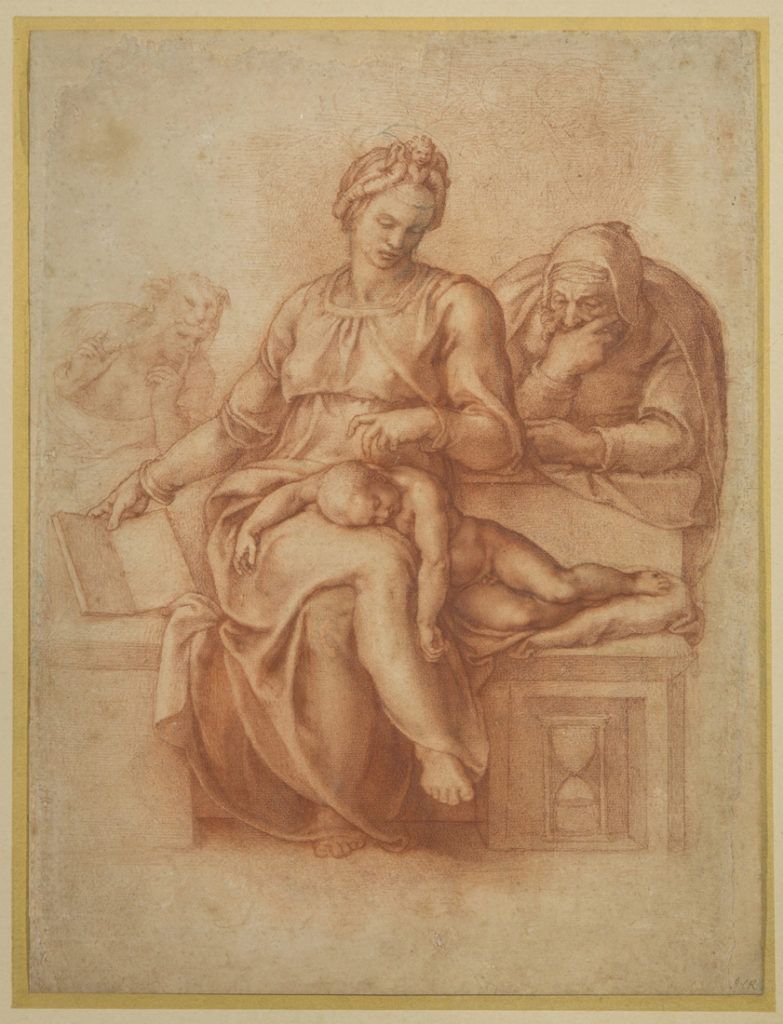Possible Michelangelo Painting Disappears From a Belgian Church Days Before Authentication
Pastor Jan Van Raemdonck had observed similarities between the canvas and a 1538 sketch by the Old Master
/https://tf-cmsv2-smithsonianmag-media.s3.amazonaws.com/filer/a5/1a/a51adb63-324e-49da-9bd6-ef2b61d7b5bb/1874-675x1024_copy.jpg)
Jan Van Raemdonck’s main profession is pastor, but as James Crisp notes for The Telegraph, the Belgian minister also boasts an unusual side hustle: namely, writing historical fiction novels, including one on his country’s most infamous art heist, a 1934 burglary that deprived Jan and Hubert van Eyck’s monumental Ghent Altarpiece of its lower left “Just Judges” panel. Now, in an ironic twist of fate, Van Raemdonck has become the central figure in his own art history mystery, a puzzling burglary surrounding a potential Michelangelo painting.
The work in question—a hefty 220-pound wood-mounted panel titled “The Holy Family”—disappeared from the Sint-Ludgerus church in Zele, a small town 45 miles north of Brussels, late last week. Crucially, The Guardian’s Daniel Boffey notes, the theft took place just days before the canvas, an unattributed painting Van Raemdonck had recently begun to suspect was crafted by the Italian Renaissance giant Michelangelo, was set to be assessed—and potentially authenticated—by art historian Maria Forcellino.
Two women visiting the church to lay flowers at its nave alerted the pastor to the painting’s disappearance last Friday morning. According to local newspaper Het Nieuwsblad, the thieves appear to have broken into the building several hours earlier, with surveillance footage revealing an unknown man stepping out into the street with the painting hoisted on his shoulders around 5 a.m. Given the canvas’ sheer size, it’s likely the burglar had at least one other accomplice, Van Raemdonck tells Het Nieuwsblad’s Cedric Lagast.
Prior to the robbery, “The Holy Family” had been a fixture in the Sint-Ludgerus church for nearly two decades. Donated to the parish by former Belgian senator Etienne Cooreman 16 years ago, the canvas was initially consigned to the corners of the chapel, but when Van Raemdonck took over the parish five years ago, he moved it into a more prominent position.
For the majority of the time the painting stood by the church’s altar, the pastor had no reason to believe it was linked with Michelangelo. Then, Sarah Cascone reports for artnet News, he chanced upon a sketch definitively attributed to the Old Master and, most importantly, bearing the exact same composition as the mysterious panel.

The 1538 chalk drawing, titled “Madonna del Silenzio,” is part of the Portland Collection, which was amassed by the British aristocratic Cavendish-Bentinck family over a 400-year period. Now on display in Nottinghamshire’s Harley Gallery, the piece depicts a sleeping baby Jesus resting on his mother’s lap as Joseph and John the Baptist look on. The scene almost exactly mirrors the Belgian “Holy Family”: Subtle differences include Mary’s head covering, which features a detailed cherubic design in the Michelangelo sketch but a simpler gauzy draping in the painting, and John the Baptist, who appears as an infant in the painting but an adult in the drawing.
According to The Guardian’s Boffey, Van Raemdonck only confided his theory to a select group of some 20 friends, family and church council members.
“I didn’t talk about my suspicion about the painting in the church,” he explains. “I wanted to wait for the experts, and if they said it was a Michelangelo I would have improved the security of the building.”
Van Raemdonck reached out to several museums in hopes of securing an authentication visit but received scant feedback. Finally, he convinced Forcellino, a Michelangelo expert from the University of Utrecht, to stop by the church and examine the painting. Before the analysis could take place, however, the work vanished—a fact authorities speculate is likely no coincidence.
Speaking to Het Nieuwsblad’s Lagast, church council chairman Johan Anthuenis notes that the thieves "were only interested in that one painting,” completely ignoring the other valuables stored within the building. As Mayor Hans Knop adds, “The fact that there is a parallel between the theft and the recent research of the pastor is plausible.”
Without the Michelangelo attribution, The Telegraph’s Crisp writes that the missing panel could be worth around €10,000, or $11,400 USD. But if the painting’s provenance can be traced to the master sculptor and painter, Time’s Eli Meixler notes that its value could skyrocket to as much as $144.8 million.
For now, Van Raemdonck can only guess how the thieves discovered the painting’s potentially storied history. Ironically, he tells Lagast, at the time of the work’s disappearance, he was actually working on a historical fiction novel about the canvas.
“It would take place in Zele, but in the time of Michelangelo,” Van Raemdonck says.
Still, he concludes, “I would not have anticipated that the painting would really be stolen."
/https://tf-cmsv2-smithsonianmag-media.s3.amazonaws.com/accounts/headshot/mellon.png)
/https://tf-cmsv2-smithsonianmag-media.s3.amazonaws.com/accounts/headshot/mellon.png)